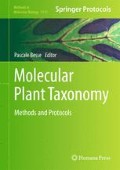Abstract
Fluorochrome banding (chromomycin, Hoechst, and DAPI) and fluorescence in situ hybridization (FISH) are excellent molecular cytogenetic tools providing various possibilities in the study of chromosomal evolution and genome organization. The constitutive heterochromatin and rRNA genes are the most widely used FISH markers. The rDNA is organized into two distinct gene families (18S-5.8S-26S and 5S) whose number and location vary within the complex of closely related species. Therefore, they are widely used as chromosomal landmarks to provide valuable evidence concerning genome evolution at chromosomal levels.
Access this chapter
Tax calculation will be finalised at checkout
Purchases are for personal use only
References
Murata M, Heslop-Harrison JS, Motoyoushi F (1997) Physical mapping of the 5S ribosomal RNA genes in Arabidopsis thaliana by multi-color fluorescence in situ hybridization with cosmid clones. Plant J 12(1):31–37
Cerbah M, Kevei Z, Siljak-Yakovlev S et al (1998) rDNA organization and heterochromatin pattern in Medicago truncatula. Cytogenet Cell Genet 81:141
Siljak-Yakovlev S, Cerbah M, Couland J et al (2002) Nuclear DNA content, base composition, heterochromatin and rDNA in Picea omorika and Picea abies. Theor Appl Genet 104:505–512
Cerbah M, Coulaud J, Siljak-Yakovlev S (1998) rDNA organization and evolutionary relationships in the genus Hypochaeris (Asteraceae). J Hered 89:312–318
Weiss-Schneeweiss H, Tremetsberger K, Schneeweiss GM, Parker JS, Stuessy TF (2008) Karyotype diversification and evolution in diploid and polyploid South American Hypochaeris (Asteraceae) inferred from rDNA localization and genetic fingerprint data. Ann Bot 101: 909–918
Zoldos V, Papes D, Cerbah M et al (1999) Molecular-cytogenetic studies of ribosomal genes and heterochromatin reveal conserved genome organization among eleven Quercus species. Theor Appl Genet 99:969–977
Siljak-Yakovlev S, Peccenini S, Muratovic E et al (2003) Chromosomal differentiation and genome size in three European mountain Lilium species. Plant Syst Evol 236:165–173
Lim KY, Matyásek R, Lichtenstein CP et al (2000) Molecular cytogenetic analyses and phylogenetic studies in the Nicotiana section Tomentosae. Chromosoma 109:245–258
Bogunic F, Siljak-Yakovlev S, Muratovic E et al (2011) Different karyotype patterns among allopatric Pinus nigra (Pinaceae) populations revealed by molecular cytogenetics. Plant Biol 13:194–200
Bogunic F, Siljak-Yakovlev S, Muratovic E et al (2011) Molecular cytogenetics and flow cytometry reveal conserved genome organization in Pinus mugo and P. uncinata. Ann For Sci 68(1):179–187
Hizume M, Aria M, Tanaka A (1990) Chromosome banding in the genus Pinus. III. Fluorescent banding pattern of P. luchuensis and its relationships among the Japanese diploxylon pines. Bot Mag Tokyo 103:103–111
Bogunic F, Muratovic E, Siljak-Yakovlev S (2006) Chromosomal differentiation of Pinus heldreichii and Pinus nigra. Ann For Sci 63:267–274
Muratovic E, Robin O, Bogunic F et al (2010) Speciation of European lilies from Liriotypus section based on karyotype evolution. Taxon 59:165–175
Godelle B, Cartier D, Marie D et al (1993) Heterochromatin study demonstrating the non-linearity of fluorometry useful for calculating genomic base composition. Cytometry 14:618–626
Sell PD (1976) Crepis. In: Tutin TG et al (eds) Flora Europaea 4. Cambridge University Press, Cambridge, pp 344–357
Siljak-Yakovlev S, Cartier D (1986) Heterochromatin patterns in some taxa of Crepis praemorsa complex. Caryologia 39:27–32
Cartier D, Siljak-Yakovlev S (1992) Cytogenetics study of the F1 hybrids between Crepis dinarica and Crepis froelichiana. Plant Syst Evol 182:29–34
Schwarzacher T, Heslop-Harrison P (2000) Practical in situ hybridization, 2nd edn. BIOS, Oxford, UK
Schubert I, Wobus U (1985) In situ hybridization confirms jumping nucleolus organizing regions in Allium. Chromosoma 92: 143–148
Raina SN, Mukai Y (1999) Detection of a variable number of 18S-5.8S-26S and 5S ribosomal DNA loci by fluorescent in situ hybridization in diploid and tetraploid Arachis species. Genome 42:52–59
Raskina O, Belyayev A, Nevo E (2004) Quantum speciation in Aegilops: molecular cytogenetic evidence from rDNA cluster variability in natural populations. Proc Natl Acad Sci USA 101:14818–14823
Datson PM, Murray BG (2006) Ribosomal DNA locus evolution in Nemesia: transposition rather than structural rearrangement as the key mechanism? Chromosome Res 14: 845–857
Geber G, Schweizer D (1988) Cytochemical heterochromatin differentiation in Sinapis alba (Cruciferae) using a simple air-drying technique for producing chromosome spreads. Plant Syst Evol 158:97–106
Conger AD, Fairchild LM (1953) A quick freeze method for making smear slides. Stain Technol 28:281–283
Schweiser D (1976) Reverse fluorescent chromosome banding with chromomycin and DAPI. Chromosoma 58:307–324
Kondo T, Hizume M (1982) Banding for the chromosomes of Cryptomeria japonica D. Don. J Jpn For Soc 64:356–358
Martin J, Hesemann CU (1988) Evaluation of improved Giemsa C- and fluorochrome banding techniques in rye chromosome. Heredity 6:459–467
Heslop-Harrison LS, Schwarzacher T, Anamthawat-Jonsson K et al (1991) In situ hybridization with automated chromosome denaturation. Techniques 3:109–116
Author information
Authors and Affiliations
Editor information
Editors and Affiliations
Rights and permissions
Copyright information
© 2014 Springer New York
About this protocol
Cite this protocol
Siljak-Yakovlev, S., Pustahija, F., Vicic, V., Robin, O. (2014). Molecular Cytogenetics (FISH and Fluorochrome Banding): Resolving Species Relationships and Genome Organization. In: Besse, P. (eds) Molecular Plant Taxonomy. Methods in Molecular Biology, vol 1115. Humana Press, Totowa, NJ. https://doi.org/10.1007/978-1-62703-767-9_15
Download citation
DOI: https://doi.org/10.1007/978-1-62703-767-9_15
Published:
Publisher Name: Humana Press, Totowa, NJ
Print ISBN: 978-1-62703-766-2
Online ISBN: 978-1-62703-767-9
eBook Packages: Springer Protocols

